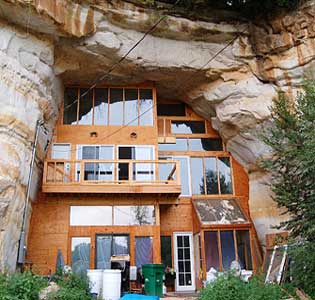Cave Homes
Living in a cave is something everybody has heard of when reading
history books or watching TV programs on prehistoric times. Building
a home in a cave was one of the efforts made by our ancestors
in order to survive.
 Cave Home in Festus, Missouri
Cave Home in Festus, Missouri |
|
As mankind progressed technologically and developed a civilization,
living in a cave remained only a distant memory. So how would we
react if somebody told us that people live in cave homes in present
times, maybe even not so far away from our own houses?
Living in a cave
Surprisingly, from a scientific point of view, living in a cave
is not such a bad idea. Underground caves and passages are usually
quiet and maintain a constant temperature - cool in the summer,
warm in the winter. Rocks and stones composing the caves are natural
materials and also provide a good, natural layer of sound insulation.
In many caves, fresh water is easily accessible as many underground
springs flow within caves.
|
So it seems like a cave home could
be a good idea - no need to build anything, only a few things
need to be adapted and the place is ready to move in to.
Unless, that is you're going to go upscale with your cave
home then the sky (or the ground) is the limit. Plus your
imagination and that of your architect.
|
|
Types of underground structures
- Artificial caves - living in a natural cave may not
be enough in terms of space, surroundings, etc. That is why
natural caves can be excavated further or, if there is a need,
completely new, human-made caves could be dug out of a hill
or mountain.
- Earth Berms - structures built with the use of earth
to form the walls. Such places look as if they are partially
buried under the ground level. Using earth shelters help maintain
a steady temperature and saves energy. Furthermore, rocks can
shelter some of these houses from behind, making them look like
half-cave homes.
- Underground caves / caves above the ground level -
a home is a home, regardless whether it is buried deep inside
a mountain or it is carved out in the rocks high up above the
ground. There are different methods of building / adapting cave
homes, depending on the individual requirements and taste.
Advantages of living in a cave home
It may seem unthinkable, but cave homes actually have a lot of
advantages and offer a lifestyle that is totally different to
the traditional one. Here is a list outlining some of the benefits
of having your own cave home:
- Cave homes are ecologically friendly and roughly 80-percent
cheaper in terms of power and heat consumption compared to conventional
dwellings
- They come will a natural layer of insulation. Rocks are also
a good sound barrier.
- Cave homes provide a natural hideout in a case of global conflict
and are also a defense against storms.
- Cave homes can be bought or built much more cheaply than traditional
above ground houses.
- And, cave homes offer a natural barrier to intruders since
there is only one side to protect instead of four.
Disadvantages of living in a cave home
- Moisture and lack of natural light
- Risk of rocks collapsing in case of an earthquake
The disadvantages can be overcome by installing large window,
preferably south-facing so that natural light comes in the cave
home all year long. Also, your builder can offer construction
techniques that will minimize the impact of earthquakes if there
happens to be one.
So, remember you don't have to be a caveman or woman (or Batman)
to live in a cave home. Green architects and builders in modern
times know how to build many different types of alternative living
spaces that are eco-friendly and appeal to environmentalists everywhere.
External Links
Cave home in Festus, Missouri or Caveland
http://www.caveland.us/
|

